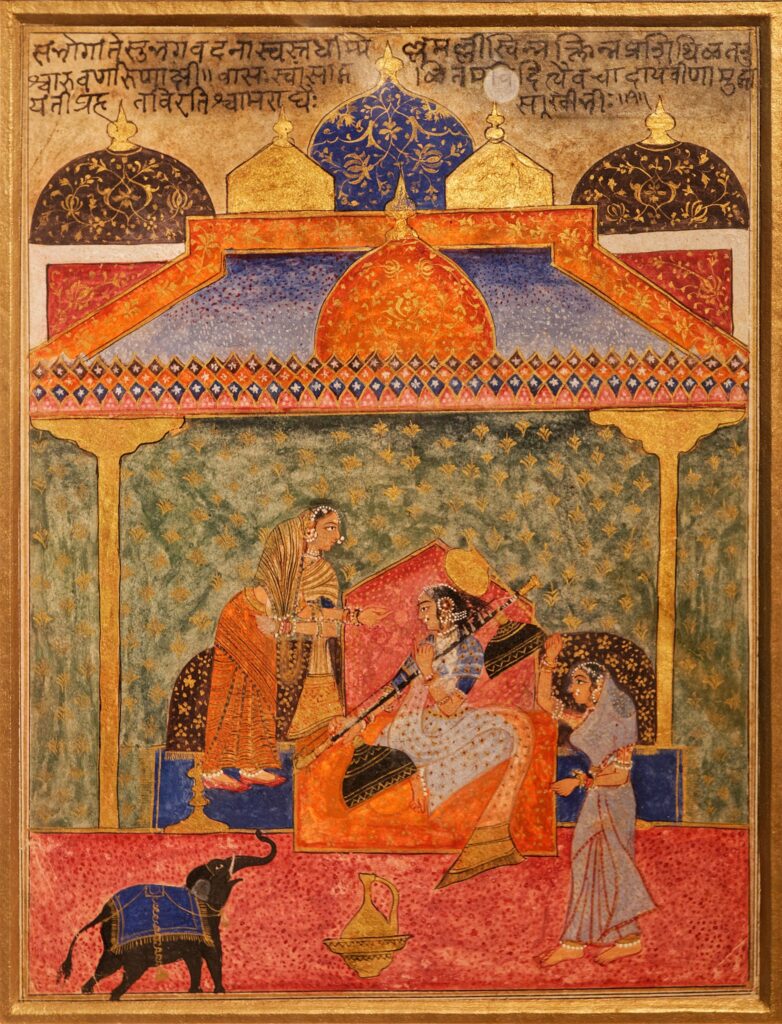
Chand Bibi Playing Polo

“Chand Bibi Playing Polo” is a famous miniature painting from the Deccan school of art, a unique style of Indian miniature painting that flourished in the Deccan region during the 16th to 18th centuries. This painting depicts the influential historical figure Chand Bibi engaged in a game of polo, showcasing not only her sporting prowess but also her leadership qualities and strategic thinking. The composition is laden with moral values that reflect the cultural and societal values of the time.
Time Period – 16th to 18th centuries
Artist – unknown
Sub School – ‘Golconda’
Compositional Arrangements
The painting is set against a backdrop of lush green landscapes, portraying the Deccan plateau’s natural beauty. The composition is balanced and intricate, following the typical features of Deccani art. The elements of the composition are arranged as follows:
- Central Focus– The central focus of the painting is Chand Bibi herself, elegantly seated on a beautifully adorned elephant. She is shown with grace and poise, wearing rich and elaborate attire that signifies her royal status. This portrays her as a strong and empowered ruler.
- Game of Polo – The foreground of the painting showcases a lively game of polo. Chand Bibi is depicted striking the ball with her mallet, exhibiting her prowess in sports. Other players and attendants are engaged in the game, adding a sense of dynamism and action to the scene.
- Elephant’s Regalia – The elephant Chand Bibi is seated on is adorned with intricate decorations and textiles, symbolizing her authority and wealth. The richness of the elephant’s attire emphasizes her royal status.
- Landscape and Architecture – The background features a detailed portrayal of the Deccan landscape, with rolling hills, trees, and flowing water bodies. In the distance, you might find architectural elements like minarets and domes, highlighting the cultural and architectural aspects of the Deccan region.
Moral Values
The painting embodies several moral values that were important in the Deccan society of that time:
- Leadership and Empowerment – Chand Bibi’s portrayal as a skilled polo player showcases her leadership qualities. This emphasizes the value of strong and capable leadership regardless of gender.
- Skill and Talent – The depiction of Chand Bibi excelling in the traditionally male-dominated sport of polo highlights the importance of recognizing and appreciating individual skills and talents.
- Strategic Thinking -Polo is a game of strategy, and Chand Bibi’s active participation in the game reflects her tactical and strategic thinking. This suggests that effective rulers must possess both physical and intellectual prowess.
- Cultural Pride – The detailed representation of Deccan architecture and landscape reflects a sense of cultural pride and attachment to the region’s heritage.
- Gender Equality – Chand Bibi’s participation challenges traditional gender roles, advocating for gender equality and women’s empowerment.
- Aesthetic Sensibilities – The intricate detailing in the painting reflects the aesthetic sensibilities of the Deccan school of art, underlining the importance of artistic expression and creativity.
Hazrat Nozamuddin Auliya and Amir Khusro

The painting titled “Hazrat Nizamuddin Auliya and Amir Khusro” is a masterpiece of the Deccan School of Miniature Painting. This painting portrays the profound spiritual relationship between Hazrat Nizamuddin Auliya, a renowned Sufi saint, and Amir Khusro, a prominent poet, musician, and disciple of the saint. The Deccan School of Miniature Painting emerged in the Deccan region of India during the medieval period, particularly during the Bahmani and Qutb Shahi dynasties. This school is known for its distinctive style that blends Persian, Indian, and Central Asian influences.
Composition
The painting is set against a lush backdrop of a serene garden adorned with vibrant flowers, flowing streams, and architectural elements characteristic of the Deccan region. The central figures, Hazrat Nizamuddin Auliya and Amir Khusro, are depicted in a semi-formal gathering within the garden. Hazrat Nizamuddin Auliya is shown as an elderly Sufi saint with a gentle demeanor, sitting on an intricately designed carpet. He is dressed in a simple white robe, representing his humility and spiritual purity.
Amir Khusro, on the other hand, is positioned near Hazrat Nizamuddin, displaying his loyalty and devotion. Khusro is shown holding a musical instrument, perhaps a sitar or a rubab, symbolizing his deep connection to both music and spirituality. His attire is elegant, reflecting his status as a royal poet-musician.
Surrounding the central figures are a few other Sufi disciples engaged in quiet meditation, illustrating the peaceful and harmonious atmosphere of the gathering. The garden’s landscape is meticulously detailed, with colourful flowers and flowing waterways, contributing to the overall aesthetic appeal of the composition.
Time Period and Sub-Schools
The Deccan School of Miniature Painting flourished from the 16th to the 19th centuries, primarily under the Bahmani Sultanate and Qutb Shahi dynasty. The painting in question likely belongs to the late 16th or early 17th century, when the Deccan region experienced a cultural renaissance under the patronage of various rulers.
Moral Values
This painting conveys several moral values:
- Spiritual Devotion – The central theme of the painting is the spiritual devotion of both Hazrat Nizamuddin Auliya and Amir Khusro. Their mutual respect and devotion highlight the importance of spiritual relationships and the mentor-disciple bond.
- Humility – The attire of Hazrat Nizamuddin Auliya in simple white robes symbolizes humility and detachment from materialism, reinforcing the spiritual values of inner richness over external appearance.
- Cultural Synthesis – The presence of Amir Khusro as a musician and poet emphasizes the harmonious blend of culture, art, and spirituality. This promotes the idea that artistic expression and devotion can coexist and complement each other.
- Respect for Elders – The positioning of Amir Khusro near his mentor signifies his respect and reverence for Hazrat Nizamuddin Auliya. This teaches the value of honouring and learning from one’s elders.
- Peace and Tranquility – The serene garden setting and the meditative disposition of the disciples convey the importance of inner peace and tranquility in the pursuit of spirituality.
In conclusion, the painting “Hazrat Nizamuddin Auliya and Amir Khusro” from the Deccan School of Miniature Painting is a portrayal of spiritual devotion, cultural synthesis, and inner peace. It encapsulates the moral values of humility, respect, and the harmony between art and spirituality. The artwork’s intricate details, lush landscape, and historical context make it a valuable representation of the Deccan School’s unique style and cultural contributions
Ragini Pathamishka

Title: “Ragini Pathamishka – Harmony of the Decan Breeze”
Time Period: 17th century, during the late Deccan Sultanates’ reign
Sub School: Bijapur School of Miniature Painting
Composition
The compositional arrangements of this painting are very appealing. Three female figures have been arranged very beautifully in the red colored four ground. In the center, a princess is shown holding a veena and is sitting on a red colored throne. On her left side, A Dashi (med servant) is standing and on the right side of the princess also a dashi is escorting her by waving a fan for the princess.
A Hukka of yellow color has been arranged in the center in the front of the princess and on the left side of Hukka . Small black elephant has been shown . in this painting, all the pillars and minarets or toms have been arranged symmetrically. at the top of the painting, an inscription has been mentioned all over (above the fine minarets shown). So, the whole composition is well composed and well balanced.
- Central Figure – Ragini Pathamishka (Personification of Harmonious Breeze)- The central figure of the painting is a graceful woman, elegantly draped in vibrant silk attire that ripples in the breeze. She stands beneath a blossoming Champaka tree, symbolizing the unique flora of the Deccan. Her serene expression reflects the tranquil nature of the breeze she personifies.
- Scenic Background– The backdrop depicts a sprawling Deccan landscape, characterized by rolling hills, serene lakes, and architecture that bears the distinct Islamic influence of the Deccan Sultanates. The use of warm and earthy tones brings forth a sense of belonging and rootedness to the region.
- Musical Ensemble – A group of musicians sits in the foreground, playing traditional Deccani musical instruments. Their melodies resonate with the harmony of the breeze, signifying the interconnectedness of nature and culture. This element highlights the Deccan’s rich cultural heritage.
- Peacocks and Nature – A pair of vibrant peacocks, known for their association with the Indian monsoon, elegantly unfurl their feathers, dancing to the rhythm of the breeze. This imagery symbolizes the joyful response of nature to the arrival of the monsoon winds.
- Moral Values- The painting embodies several moral values inspired by the Deccan ethos:
Harmony – The central theme of the painting, the harmonious breeze, symbolizes the importance of balance and unity in both nature and society.
Respect for Tradition – The inclusion of traditional musical instruments and clothing emphasizes the preservation of cultural heritage.
Appreciation of Nature – The depiction of peacocks and natural landscapes encourages viewers to cherish and respect the environment.
Connection with the Divine – The tranquility of the scene invites contemplation and a sense of spiritual connection.
- Color Palette
The color palette draws inspiration from the Deccani aesthetic, featuring warm earthy tones, deep blues, and vibrant reds. Gold leaf accents reflect the influence of luxury and opulence often seen in miniature paintings of the era.
- Border Design
The border is intricately designed with floral motifs and geometric patterns, echoing the architectural marvels of the Deccan Sultanates. These ornate borders are characteristic of the Bijapur school.
By blending elements of the Deccan landscape, cultural heritage, and a sense of harmony, “Ragini Pathamishka” becomes a celebration of both artistic and moral values. This imagined composition captures the essence of the Deccan School of Miniature Painting while highlighting the interconnectedness of nature, culture, and spirituality during the late 17th century.